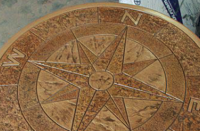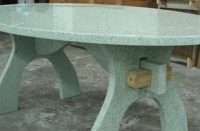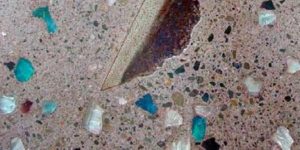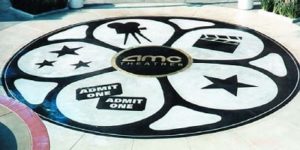
At a busy street corner in Beverly Hills, motorists fill their tanks at the world’s first LEED-certified gas station, which features a gleaming canopy of recycled aluminum that looks like a cross between a UFO and a vintage Airstream trailer. The BP service station, called Helios House, is as green as a place selling fossil fuel can be, from the solar panels and drought-tolerant landscaping on the roof to the crushed and tumbled Coke bottles and post-industrial mirror shards in the concrete pavement.;

The recycled glass aggregate in the concrete not only adds to the LEED points, it also complements – and literally mirrors – the structure’s design.
That combination of environmental and aesthetic qualities underscores the appeal of glass aggregate: It’s good for the planet, and looks good too.;
Mike Miller, founder of the group of northern California artisans known as The Concretist and the contractor behind Helios House’s concrete, is a big proponent of glass aggregate. He’s such a fan that the exposed aggregate in the concrete floor in his office is a mix of crushed and tumbled red brick and 3/4-inch pieces of amber-colored beer bottles. His partner, Kelly Burnham, is also a fan. Her office floor contains fist-sized chunks of post-industrial lampshades mixed with broken ashtrays and pieces of steel.;

“Kelly and I really like glass,” Miller says. “We consider it a very simple, basic, important building material, just like wood, steel, stone and concrete itself.”;
Glass brings a whole new set of variables to a concrete artisan’s palette. The most unique is probably depth. Unlike rock, sand and other kinds of aggregate, glass aggregate allows you to actually see into the matrix. The lighter the glass, the stronger the effect.;
Glass also multiplies color and contrast possibilities. Combining light and dark colors of glass for a terrazzo effect is one popular approach, and coordinating a single color of glass with the color of the matrix is another.;

Steve Melnick, owner of Concrete Central in Huntington, N.Y., says that the numerous choices can actually overwhelm clients.;
“We offer the entire Benjamin Moore color wheel plus 40 or 50 stains,” he says. “When you add glass aggregate and all of its variations, it gets really mind-boggling. So you have to really sit down and help people design what they want.”;
Glass aggregate is typically graded by size, and sizes can range from sand-like powder to fist-sized chunks. Using finely ground clear glass in place of sand can make for purer colors of the matrix. Finely ground glass also lends itself nicely to highly polished finishes. Putting a high polish on concrete loaded with finely ground, earth-toned glass aggregate can create marble or granite effects.
 Blending glass with other types of aggregate can create interesting contrasts. In Charleston, S.C., Harry Gressette of Grescon Construction LLC mixes glass with exotic stone, such as white marble, cherry granite, and – one of his favorites – Nova Scotian granite.;
Blending glass with other types of aggregate can create interesting contrasts. In Charleston, S.C., Harry Gressette of Grescon Construction LLC mixes glass with exotic stone, such as white marble, cherry granite, and – one of his favorites – Nova Scotian granite.;
“The Nova Scotian granite is white with black speckles, and it’s really beautiful, especially with dark blue glass,” Gressette says.;
To maximize concrete’s environmental friendliness, recycled glass aggregate can be used integrally as a substitute for some or all of the stone aggregate. But to ensure maximum coverage, contractors typically seed the glass, float it into the wet concrete, then trowel the surface closed.;
Exposed glass aggregate is revealed just as other exposed aggregates are, typically through washing, diamond grinding or sandblasting.;

The clarity of the glass can be a factor in picking the method used to reveal it. A supertransparent glass, for instance, will lose clarity with sandblasting. Washing or diamond grinding and polishing would be better options in that case.;
Decorative concrete industry instructor Glen Roman once worked on a job with Las Vegas contractor Chief Concrete for an auto dealership that wanted the logos of Chrysler, Dodge and Jeep to appear in a trio of concrete pads where the cars would be displayed. Chief Concrete seeded black glass into the freshly poured pads, gave the surface a very light broom finish, sealed the concrete, applied stencils, and sandblasted away, revealing deep black logos in the gray concrete.;

“We sandblasted into the night,” he says. “It was a tough haul but it came out great. Unfortunately, the only time you could really see it was right after we finished. Now it’s covered with cars.”;
Cullet vs. specialty glass
Glass aggregate can be obtained from a variety of sources. Regional recycling centers may have cullet – crushed bottles and other glass – cleaned and sorted by size and color. Nationally, specialty glass manufacturers melt down bottles and other recycled glasses to produce glass aggregate for terrazzo floor contractors, landscapers and decorative concrete artisans.;
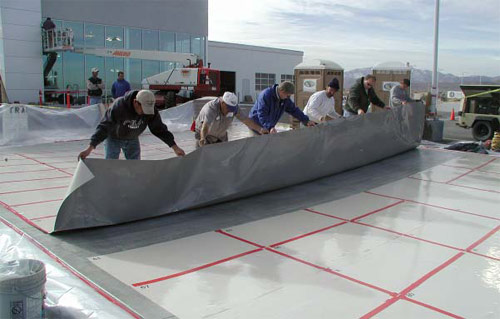
Sometimes concrete artisans simply use what they have on hand. While conducting a concrete countertop training seminar, Scott Hogue of Artistic Concrete Surfaces LLC in Spokane, Wash., used crushed blue Skyy Vodka bottles and brown Henry Weinhard’s beer bottles as an exposed aggregate.;
Why that combination?;
“Cause that’s what the guys were drinking,” he says. Cullet tends to be flatter and less translucent than the specialty glasses, which typically have fuller, more irregular shapes, like crushed gravel. The purer colors and clarity of specialty glasses appeal strongly to many artisans. But others prefer cullet because its flatness means it takes less grinding to expose.

The color choices among specialty glasses go far beyond the limited colors of cullet. The irregularly shaped glass aggregate sold by American Specialty Glass in North Salt Lake, Utah, comes in 23 colors. Sizes range from a talc-like sand substitute to 1/2 inch to 8-inch chunks. The company’s jelly bean glass, which looks so much like the candy it’s named after that it comes with a do-not-eat warning, is available in 13 flavor-themed colors, such as Root Beer and Concord Grape.;
The company will send you few free samples upon request, or, for $10, a complete terrazzo floor sample kit. Perhaps the biggest drawback to using glass aggregate is its potential to trigger an alkali silica reaction (ASR). This occurs when silica in the glass combines with the alkali in the portland cement to form a gel that swells in the presence of moisture. The reaction might happen right away or it might not happen for decades, but in either case it can lead to cracking. Any source of moisture can set it off, including excess water in the concrete, mopping, and so on.;

But ASR can be prevented. Engineers at Columbia University who work to develop more environmentally friendly building materials have found that the reaction doesn’t happen if the glass is ground finely enough to pass through 50-mesh or smaller screen. They also report that green glass does not cause ASR, thanks to the chromium oxide that gives the green glass its color.;
And the researchers found that the mineral admixture metakaolin will suppress the reaction when it replaces at least 20 percent of the portland cement – an effective but expensive solution.;

Other studies have shown that fly ash, a cheaper alternative to metakaolin, also suppresses ASR. An East Coast company called CeraTech Inc. uses fly ash as the main ingredient in Eccorok, a substitute for portland cement in countertops and other architectural surfaces. When Eccorok is used with recycled glass aggregate, it produces a concrete composed of nearly 100 percent recycled materials, which is good for both sustainability and marketability.;
“I am not an environmentalist,” says Mark Celebuski, general manager of Pinnacle Cast Concrete in Brownstown, Penn., who helped CeraTech adapt Eccorok for countertops. “But if I can make things people want to buy and they’re green, I’d rather do that.”
www.americanspecialtyglass.com
www.chiefconcrete.com
www.ceratec.com
